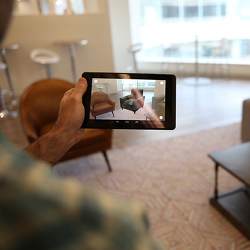
It is hard enough to visualize how an article of clothing will look on you when viewing it online, so imagine the difficulty of choosing a big-ticket item like a piece of furniture. Online retailer Wayfair thinks it has found a solution: in June, the company launched an augmented reality (AR) app that lets shoppers see what furniture and décor will look like in their homes before they make a purchase.
The app is based on Google’s Project Tango mapping/three-dimensional (3D) technology, and will be available on the Lenovo Phab 2 Pro smartphone in September.
It is not just e-commerce retailers that are eyeing the technology. Thanks to growth in the number of mobile software applications and hardware enhancements, AR is gaining traction in different vertical industries as well, including manufacturing, healthcare, government and military, according to Eric Abbruzzese, a senior analyst at ABI Research, which is forecasting AR smart glasses will generate $46 billion in revenue in 2021. Other use-cases for the technology are in education, construction and architecture, and training, industry observers say.
AR is sometimes confused with virtual reality. While both change how a user experiences reality, AR "layers computer-generated enhancements atop an existing reality in order to make it more meaningful through the ability to interact with it," according to enterprise AR platform provider Augment. Virtual reality recreates a real-life environment or situation through the use of artificial, computer-generated simulations. AR is more of an enterprise play, while VR is used more frequently in the consumer space, according to ABI Research.
AR will win out in the enterprise both in the near and long term, but VR will still have a notable presence, notes Abbruzzese. "Mobile AR will be dominant in the beginning, thanks to lower cost and quicker implementation; however, smart glasses will be the face of enterprise AR over the coming years, as the possible increases in efficiency and safety are significant."
Certain dedicated AR installations, such as a telepresence room, will be used in enterprise settings as well, he adds. Enterprise VR deployments will be focused around immersive simulation and training environments, as well as enterprise video usage. Any training or simulation environment that requires accurate spatial interaction and immersion will use VR over AR, Abbruzzese says.
"While VR offers an immersive and revolutionary way to consume content, the target market is still relatively niche,’’ he says. "Efficiency, safety, and productivity are pillars throughout the enterprise, however, and AR will continue to push the opportunities in these categories further."
Neither AR nor VR are expected to have a significant impact on IT and IT spending, says Lewis Ward, a research director at IDC, which has identified AR/VR as one of six "Innovation Accelerators that will drive digital transformation in the coming years by opening new revenue streams and changing the way people work." IDC is forecasting AR hardware shipments to increase from 0.4 million in 2016 to 45.6 million in 2020, representing a compound annual growth rate of almost 190%.
Besides AR smart glasses, other AR/VR devices include screenless viewers (defined by IDC as using the screens of certain smartphones to facilitate an AR/VR experience; an example is the Samsung Gear VR), tethered VR devices like the Oculus Rift, and standalone head-mounted displays in which the computing power is built into the headset like Microsoft’s HoloLens, says Ward.
Other projections also indicate both technologies will skyrocket in the next few years. In mobile in particular, AR/VR will reach $150 billion in revenues by 2020, "with AR taking the lion’s share around $120 billion,’’ according to management consulting firm Digi-Capital.
Wayfair sees its first foray into AR as a "long-term play," says Mike Festa, director of Wayfair Next, the company’s research and development team. "With no physical stores, one of the barriers for people is how a product will look in their home from different angles. With 3D you can get an idea, but with this new app you can see exactly how it will look in your space without using a tape measure."
The Wayfair app uses a person’s camera feed so they virtually "place" a product in the room in which it will reside, at an accurate scale. Although there are similar apps for tablets, Festa thinks they typically do not work well. "If you move the device too quickly, the scale isn’t accurate and products will drift around," he explains.
Right now Wayfair has 3,000 pieces of furniture with a 3D representation. Festa acknowledges there is a "small audience that will be interested in the Phab 2 for some of the content," but believes AR technology will be more common in smartphones within the next three years.
"Application developers will be ones driving the adoption and the interest in augmented reality," Festa says. "The way things are going right now, it’s inevitable the hardware will be there; it works well, so the next step is developing and producing these interesting experiences and we’ve done that at Wayfair … It’s not a gimmick."
Esther Shein is a freelance technology and business writer based in the Boston area.



Join the Discussion (0)
Become a Member or Sign In to Post a Comment